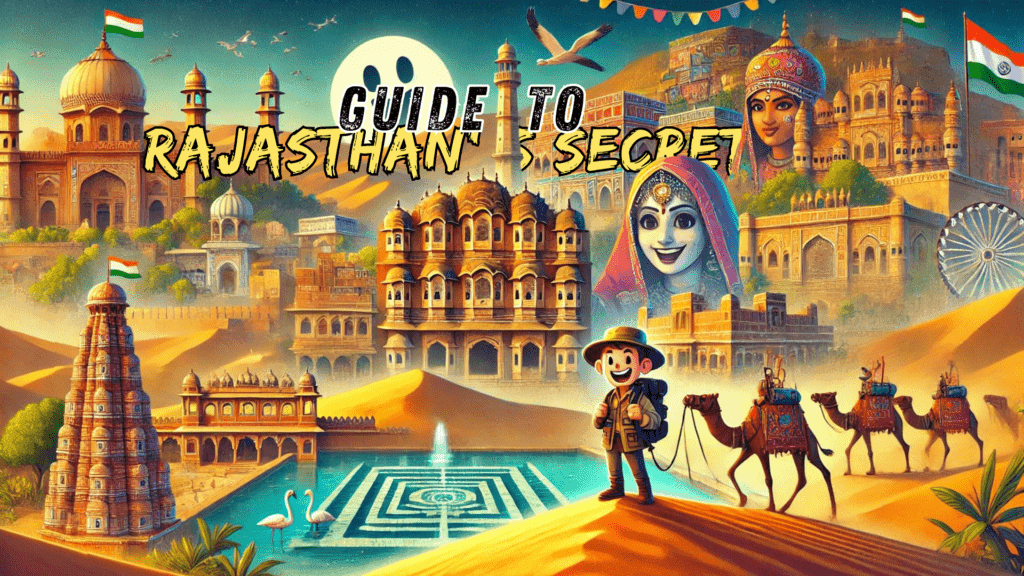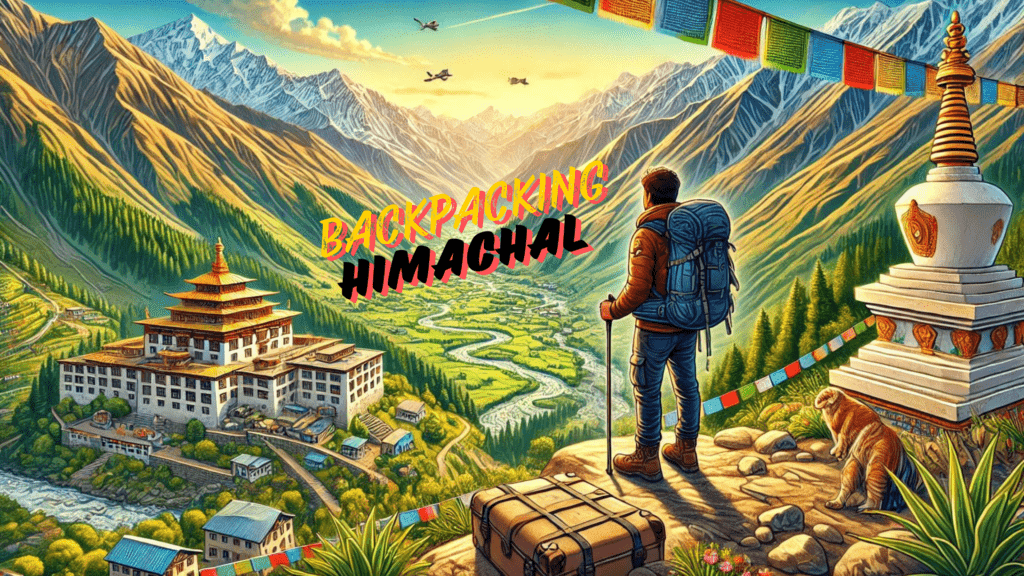Namaste, intrepid travelers! Are you ready to venture beyond the well-worn paths of Jaipur’s pink streets and Udaipur’s shimmering lakes? Welcome to the lesser-known side of Rajasthan, where every corner holds a secret waiting to be uncovered!
Did you know that Rajasthan is home to the only living fort in India? Or that there’s a lake that mysteriously appears and disappears? This land of kings is full of surprises that’ll make your jaw drop faster than you can say “Padharo Mhare Desh“!
As someone who’s wandered through hidden step-wells, feasted in desert camps, and marveled at frescoed havelis, I can tell you that the real magic of Rajasthan lies off the tourist trail. So, dust off your explorer’s hat, and let’s embark on a journey to 7 hidden gems that’ll make your Rajasthan trip truly unforgettable!
1. Bhangarh Fort: A Place of Stories and Mystery
Get ready to enter a place where history and mystery come together at the well-known Bhangarh Fort. This place is in the Alwar district and is from the 17th century. It is known to be very scary and is officially one of the most haunted places in India!
When you walk around the old ruins of temples, palaces, and markets, you can almost listen to the stories from long ago. There is a story that says a tantric priest put a curse on the city, which caused it to fall and be left behind. Whether you think ghosts are real or not, the spooky feeling will make you feel scared.
The fort is a perfect place for photographers, especially during the beautiful golden hours. The way light and shadow play on the old stones makes a scene that is both beautiful and a little spooky. But keep in mind, that the Archaeological Survey of India does not allow entry before the sun rises and after it sets. Believe me, you really don’t want to try out those spooky stories!
If you love history, you should visit Ajabgarh Fort, which is nearby. It is not very crowded, but it gives you a wonderful look into the past of Rajasthan. This is a great addition to your Bhangarh adventure.
Best advice: Go in the winter months for nice weather to explore and a magical morning mist that makes the fort feel spooky.
2. Shekhawati Region: The Open-Air Art Gallery of Rajasthan
Welcome to Shekhawati, a place where each wall shares a story! This area in northern Rajasthan is well-known for its painted havelis, which are big houses that make you feel as if you have entered a lively art gallery.
Begin your trip in Mandawa, which is often referred to as the “open-air art gallery.” The havelis here are decorated with bright frescoes showing many things, from stories of gods and goddesses to British officers riding on steam engines. Make sure to visit the well-known Castle Mandawa, which has now been turned into a heritage hotel.
Next, go to Nawalgarh, which has some of the best-preserved frescoes in the area. The Morarka Haveli Museum gives a great view of how these beautiful artworks are restored.
In Fatehpur, you should definitely visit the Nadine Le Prince Cultural Centre. This restored haveli shows both old and modern art, connecting the past with the present.
To have a really deep experience, you should stay in one of the restored havelis. Think about waking up with art that is hundreds of years old all around you – it feels like you are in a museum, but much more comfortable!
Do you want to bring out the artist inside you? Many local artists provide workshops for fresco painting. It is a great way to show respect for the skill and patience that was used to make these amazing works of art.
Keep in mind, the best way to see Shekhawati is to walk around without any specific plan. Every lane has something surprising, and every haveli has a special treasure waiting to be found. So wear your walking shoes and let the art lead you!
3. Chand Baori Stepwell: A Beautiful Design in Abhaneri
Get ready to be amazed by the incredible architecture of Chand Baori. This stepwell is found in the small village of Abhaneri and shows the clever engineering skills of ancient India.
When you get close to Chand Baori, the ground appears to drop down, showing a beautiful geometric design that goes down 13 levels. The stepwell has 3,500 narrow steps that are arranged very neatly. These steps go down to a green pool of water at the bottom.
Chand Baori was built in the 9th century. It is not only beautiful but also served a useful purpose for saving water in the dry climate of Rajasthan. In the monsoon season, the well would get filled with water, which would be enough for the whole year. The steps made it easy for people to go down to the water level as it slowly went down.
To get the best photos, go early in the morning. This is when the sun rises and makes nice patterns of light and shadow on the steps. This place is very good for photographers, so make sure to take your camera with you!
Next to the stepwell, there are the remains of the Harshat Mata Temple. This temple is dedicated to the goddess who represents joy and happiness. The detailed carvings on the temple walls give us a look at the building style from the 10th century.
Did you know? Chand Baori has appeared in many Hollywood films, such as “The Dark Knight Rises” and “The Fall.” So, you should not be surprised if it seems familiar!
Here is a good tip: When you go to Chand Baori, also visit the nearby Bhangarh Fort. This way, you can enjoy a whole day filled with amazing history.
4. Kumbhalgarh Fort: The Big Wall of India
Step aside, China! India has its own “Great Wall,” and it is really something to see. Welcome to Kumbhalgarh Fort, which has the second-longest continuous wall in the world, just after the Great Wall of China.
The Kumbhalgarh wall stretches for 38 kilometers and winds through the Aravalli hills. It provides amazing views at each turn. This site was built in the 15th century by Rana Kumbha. It is recognized as a UNESCO World Heritage Site and shows the military architecture of the Rajputs.
When you walk through the big Hanuman Pol gate, it feels like you are going back in time. The fort complex has more than 360 temples, palaces, and gardens inside its walls. Make sure to see the beautiful Palace of Clouds (Badal Mahal) at the highest point of the fort – the view from this place is really amazing.
People who love history, pay attention: Kumbhalgarh is the place where Maharana Pratap was born. He is known as one of the greatest warriors of Rajasthan. As you walk along the ramparts, you can nearly hear the sounds of battle cries from the past.
To have a really wonderful experience, make sure to stay for the evening sound and light show. When the fort lights up and the tale of its glorious past is shared, you will feel like you have gone back in time to the days of brave Rajput warriors and clever plans.
People who love adventure can have fun trekking on the fort wall or looking around the Kumbhalgarh Wildlife Sanctuary that is around the fort. You never know, you could see a leopard or maybe even two!
It is a good idea to wear comfortable shoes and take some water with you. This big fort requires a lot of walking and climbing to explore.
5. Pokaran: A Place Where Life in the Desert Flourishes
Do you believe that the desert is just sand and has no excitement? Think once more! Pokaran is a small town located in the middle of the Thar Desert, and it is ready to change how you think.
Begin your journey in Pokaran by staying at a desert camp. Think about sleeping under a sky full of stars, with soft golden sand dunes all around you – it’s a moment that will make you forget all about fancy five-star hotels!
A visit to Pokaran is not complete if you do not go on a camel safari. As you move gently on your camel, look at the desert scenery spreading out in front of you. The way light plays on the sand dunes when the sun rises or sets is something every photographer dreams about.
If you love history, you should definitely visit Pokaran Fort, which is also called “Balagarh.” This fort from the 14th century is a strong watchtower in the desert. Its yellow sandstone walls mix well with the land around it. The museum in the fort has a great collection of old weapons and small paintings.
Pokaran is well-known for its pottery. Go to a nearby potter’s workshop to watch talented craftsmen change clay into lovely pieces of art. You may even get an opportunity to try using the potter’s wheel!
If you want to experience local culture, plan your visit during the Ramdeora Fair, which takes place in August and September. The fair draws many devotees and gives a lively look at Rajasthani traditions.
Did you know? Pokaran was the place where India conducted its nuclear tests in the years 1974 and 1998. You cannot go to the test site, but you can visit the Pokaran War Museum to know more about India’s military history.
6. Barmer: The Desert City That Is Often Overlooked
Welcome to Barmer, a city where time feels like it has stopped. Barmer is in the middle of the Thar Desert. It shows the rich culture of Rajasthan and is away from the busy tourist spots.
Begin your journey in Barmer by visiting the Garh Temple, which is located on a high rocky hill. The view of the city from this place is really nice and makes the climb worthwhile. Make sure to see the detailed carvings on the temple walls – they show the great skill of the craftsmen from this area.
If you want to learn more about Jain culture, you should go to the Nakoda Jain Temple. The beautiful design of the temple and its calm environment make it a place everyone should visit, no matter what their religion is.
Barmer really becomes lively during the yearly Barmer Festival, which usually takes place in March. This lively celebration of desert culture includes folk music, dance shows, and exhibitions of local handicrafts. This is a wonderful experience for all your senses that you must not miss!
When we talk about handicrafts, Barmer is famous for its textiles and woodwork. Walk around the local markets to watch artisans working. They make beautiful embroideries and carved wooden things. These are great souvenirs to bring home a piece of Rajasthan with you.
If you want to have a unique experience, you should go on a day trip to the Kiradu Temples, which are around 35 kilometers away from Barmer. These temples, known as the “Khajuraho of Rajasthan,” were built in the 11th and 12th centuries. They have beautiful stone carvings that are as impressive as those found in more famous places.
It is a good idea to know that Barmer can be very hot in summer. So, it is better to plan your visit in the winter months for a more pleasant experience.
7. Sambhar Lake: The Shining Illusion of the Desert
Get ready to be surprised by the stunning beauty of Sambhar Lake, which is the biggest inland salt lake in India. This big saltwater lake looks like it comes and goes, just like a mirage. It is a special environment that many tourists often miss.
The lake has a very strange and beautiful view. It has a large area of white salt and pink water, which is caused by algae and bacteria that live in salty places. This makes it a great spot for photographers. In the winter months, the lake becomes a safe place for migratory birds, like flamingos, making the area a great spot for birdwatchers.
Visit the salt pans to see how salt is made using old methods that people have been using for many years. You can also walk on the salt crust – it feels just like walking on the moon!
To take a journey to the past, visit the deserted Sambhar Lake Town. Once, this town was very busy with the salt trade. Now, it feels like time has stopped. The big havelis and old colonial buildings are slowly being taken back by nature. It is a very beautiful reminder of how time goes by.
Make sure you don’t miss the opportunity to ride the Sambhar Salt Lake Railway. It is one of the few metre gauge railways that are still left in India. The train moves slowly through the salt pans, giving a special view of this interesting landscape.
To have the best time, it is good to plan your visit from October to March. During this time, the weather is nice and you can see the migratory birds.
Here is a helpful tip: The sunrise and sunset at Sambhar Lake are very beautiful and special. The changing light colors the landscape in many shades that you really have to see to believe.
Conclusion
When the sun goes down over the golden sands of Rajasthan, it creates long shadows on old forts and colorful havelis. You will see that the real beauty of this special place is found in its hidden spots. From the spooky ruins of Bhangarh to the shining stretch of Sambhar Lake, each of these hidden treasures has a story that is ready to be discovered.
So, what are you waiting for, my friends who love adventure? Now is the moment to move away from the busy crowds and explore the hidden treasures of Rajasthan. If you love history, enjoy culture, or just want to explore places that are not very common, these seven destinations offer experiences that you will remember long after the dust of the desert has cleared.
Always keep in mind that the greatest journeys are the ones that make us think differently and allow us to feel new amazing things. So pack your bags, learn how to say “Khamma Ghani” (which is a greeting in Rajasthan), and prepare for an adventure that will make 2024 the best year you have ever had. The hidden treasures of Rajasthan are inviting you. The desert winds are sharing old secrets, and the warm hospitality of Rajasthan is ready to welcome you. See you in the place of kings and queens!



